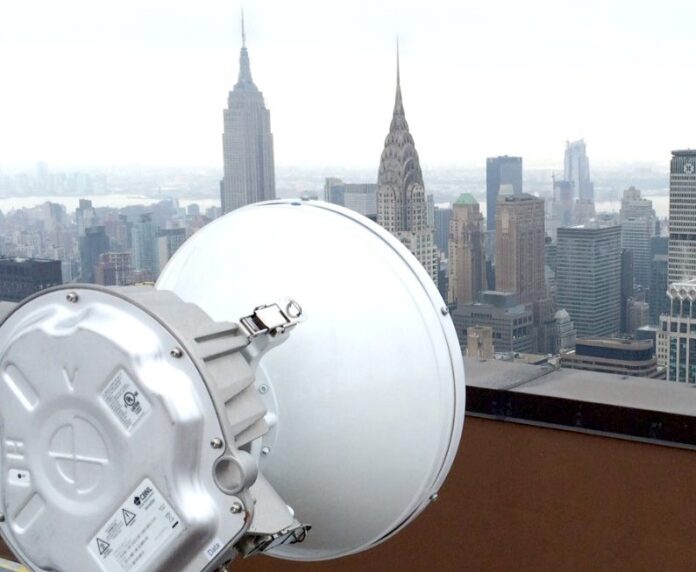Last-mile wireless infrastructure is set to see a growing influence from the use of millimeter-wave spectrum bands to meet ‘5G’ needs
The demand for high-capacity, carrier-grade enterprise broadband in major U.S. cities is growing, fueled by a surge in data usage and cloud services. With fast connectivity now a fundamental business requirement, carriers are under increasing pressure to quickly and cost-efficiently provide the capacity their customers require.
However, rapidly scaling infrastructure to meet this demand has historically proved challenging. While many U.S. cities have large wired networks, extending their reach to backhaul the growing number of mobile and fixed broadband connections can be expensive and time-consuming. In light of such challenges, wireless is playing a growing role. Yet despite its quick time to market, the common carrier spectrum used for traditional fixed wireless has become congested and expensive to acquire.
In contrast, higher frequencies, such as millimeter wave, are largely untapped and widely available across the U.S. The industry has been quick to identify this resource and has developed a new range of last-mile solutions that leverage millimeter wave to provide carriers with a more efficient path to scale network capacities – key to remaining competitive in a dynamic market where incumbent local-exchange carriers, competitive local-exchange carriers, cable companies and internet service providers are all vying for business.
Higher frequencies – a cost-effective strategy to scale capacity
Why are frequencies of 28 gigahertz and above able to offer such a compelling solution in the U.S.?
First, millimeter wave is a largely untapped resource and cheaper to acquire than traditional bands of 24 GHz or below, both per megahertz and in absolute terms. The 39 GHz band, for example, is available nationwide in the U.S., including in each of the 175 economic areas. There is an average 800 megahertz of 39 gigahertz available in the 30 largest U.S. cities – enough bandwidth to backhaul the busiest LTE or fixed wireless connection. With common carrier bands often congested and expensive to acquire in major cities, higher frequencies offer carriers a huge opportunity to cost-effectively scale last-mile capacities to the multiple gigabits per second needed in the 5G landscape.
A competitive advantage for CLECs
While CLECs have historically built their business models on leasing lines and exchanges from ILECs, a desire to access new customers has seen an increasing number of CLECs invest in infrastructure beyond their leased footprint.
However, while building fiber networks undoubtedly presents huge opportunities to carriers, they are complicated, time-consuming and expensive to deploy. Therefore, the ability of millimeter wave to provide a more cost-effective strategy to roll out carrier grade connectivity provides a compelling proposition. The opportunity is compounded by the fact many DSL lines are approaching end-of-life, meaning ILECs and CLECs are being forced to find an efficient means of upgrading links if they are to offer the service-level agreements their customers demand.
Fortunately, a new breed of innovative wireless solutions have recently been developed that utilize the higher frequency bands available in the U.S. and have already gained significant traction.
New opportunities in 39 GHz licensed PMP
While traditional point-to-multipoint has always played a prominent role in last-mile connectivity, its use of lower frequency bands has limited its spectral efficiency and has historically struggled to provide the capacity or quality of service required. The move of PMP into millimeter wave allows carriers to benefit from the cost efficiency of the architecture, without the drawbacks associated with congested spectrum. This means carriers can provide guaranteed bandwidth to each customer and build hub sites of hub to 13.2 gigabits per second.
Licensed 39 gigahertz PMP follows the successful introduction of the technology in the 28 GHz band just under two years ago. Since launching, 28 gigahertz licensed PMP has already been deployed in nine states – including five networks in New York City. With applications ranging from fixed wireless (enterprise and residential), backhaul and smart city applications, the business case of licensed PMP offers a vital role in middle- and last-mile strategies.
Adoption has been driven by the fact licensed PMP can be faster to deploy and is up to half the cost for a high-capacity link compared to competing carrier-grade point-to-point technology. This was highlighted in a recent report by Real Wireless, which revealed that for the same investment over a five-year period, licensed PMP can enable an ISP to generate 1.8 times higher return on investment than PTP.
In addition to the reduction in equipment and simplified deployment activity associated with an area based deployment, licensed PMP is able to drive further return on investment through more efficient use of spectrum. These gains are driven by time division multiple access scheduling and the innovative reuse of spectrum, which enables an overbooking ratio of 4-to-1 to be realized without any deterioration in quality of service.
As we move toward wider channels, available nationally through flexible leasing at 39 gigahertz, you can see how efficiencies of this scale can provide a highly effective path to the gigabit-per-second network speeds needed to support future 5G services.
Meeting next-generation capacity needs
Following the quick adoption of licensed PMP in 28 gigahertz, we expect the 39 gigahertz variant to play a leading role in the future communications landscape of major cities. Millimeter wave is set to provide a faster and more efficient means for carriers to expand their networks beyond what was previously feasible and launch the next-generation services their customers demand.

Mark Ashford, VP North America at CBNL, has more than 20 years experience in the wireless industry, gained in a range of multinational commercial, technical and strategic roles. Ashford is responsible for leading U.S. business and developing CBNL’s transformational business partnership initiatives. Before joining CBNL, Ashford worked for both AT&T/Lucent Technologies for 12 years as well as for Apertio, where he supported the successful sale and integration of the company in Nokia. He is an Associate Member of the Chartered Institute of Management Accountants and has a BSC in physics from Imperial College, London.
Editor’s Note: In an attempt to broaden our interaction with our readers we have created this Reader Forum for those with something meaningful to say to the wireless industry. We want to keep this as open as possible, but we maintain some editorial control to keep it free of commercials or attacks. Please send along submissions for this section to our editors at: dmeyer@rcrwireless.com.

